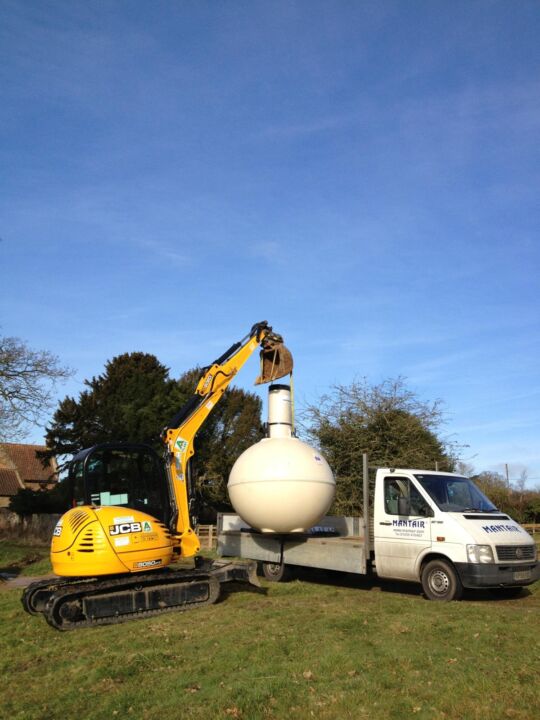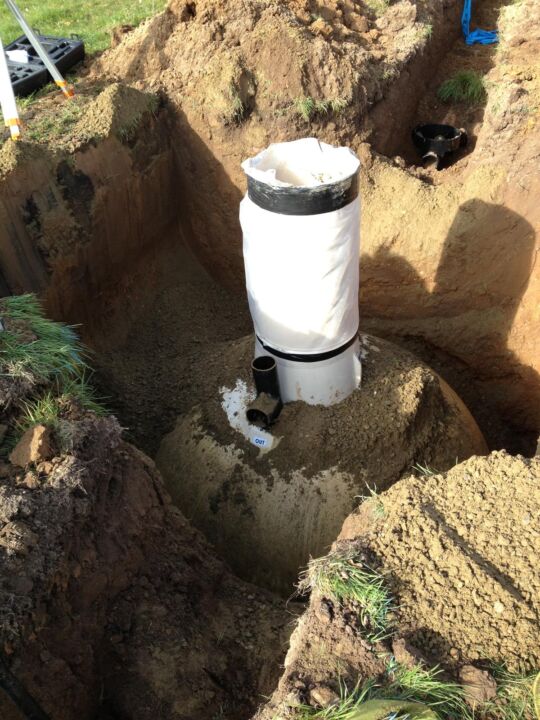
What is a Septic Tank?
Septic tank systems have been widely used in rural areas of the UK since the early 1900’s for areas where mains drainage is not available or the cost of connection is prohibitive.
A septic tank receives all of the waste water from the house, including toilet, laundry, bathroom and kitchen waste. The main purpose of a septic tank is to separate the solid material and allow the sludge formed to undergo a process known as anaerobic digestion. This has the effect of reducing the sludge volume and therefore the frequency of septic tank emptying by vacuum tanker.
The effluent from a septic tank is disposed of to a soakaway. Under no circumstances should it be allowed to discharge to a ditch or stream. Such a discharge is an offence under the Public Health and Water Resources Acts and renders the offender liable to prosecution by the Statutory Authorities. With environmental authorities becoming more stringent, the use of septic tanks has declined in recent years and need for sewage treatment plants has increased.
As you can imagine, there can be many problems with septic tanks, but Mantair are market leaders in septic tank solutions and so we’ve listed the most common septic tank problems and solutions on a separate page.
Components of a Septic Tank System
The components of a septic tank soakaway system are the septic tank, which in traditionally built systems can be one or two chambers, and the underground soakaway network.
Anaerobic digestion takes place within the septic tank whereby anaerobic micro-organisms develop and partially degrade the receiving waste water. Within the septic tank solids settle to the floor of the tank and materials such as tissue float to the top of the liquids and form a scum layer.
Within traditionally built tanks there are normally ‘T’ pipes located on the inlet and outlet. The purpose of ‘T’ pipes is to prevent floating material and settled solids from passing through the septic tank and into the soakaway network. Modern septic tanks which are manufactured from Fibreglass or Polyethylene normally have internal baffles to prevent floating and settled materials from passing into the soakaway.
Septic tank soakaways typically consist of a system of sub-surface irrigation pipes which allow the effluent to percolate into the sub-strata. They may be used where the sub-strata is sufficiently permeable and in locations which are not prone to flooding or water logging at any time of the year.

Septic Tank Sizing
Septic tank systems should have as a minimum an operating capacity of 2700 litres for up to 4 persons in full time residence. The size should be increased by 150-180 litres for each additional user. The operating capacity of a septic tank is the volume below the outlet from the tank. If a septic tank does not have enough operating capacity this will result in finer solids passing through the tank and blinding off the soakaway system.
In many traditionally built septic tanks, which are constructed from brick or concrete, the operating capacity is less than 2000 litres and as a result these tanks do not operate effectively. Older septic tanks are often smaller in size due to the daily flow being discharged to these tanks at the time of their construction being far less than modern day usage.
Septic Tank Design
Factory made septic tanks are available in glass reinforced plastic (GRP) or polyethylene and should meet the requirements of BS EN 12566-1. These factory made septic tanks are normally a single tank system and are available as a cylindrical or spherical tank. Within these tanks there are baffles which are designed to assist in the settlement and separation of solids and floating materials.
Traditionally built septic tank systems are usually one or two chamber systems. Two chambers systems can be either two separate tanks or a single tank with an internal partition wall. The floor of the tank is usually constructed of concrete and the walls are suitably rendered brickwork, concrete or prefabricated blocks. The tank should clearly be watertight and have the strength to withstand the weight of liquid contained and any external pressure.
Many septic tanks pre-dating 1965 would be in the form of two separate chambers, the first being a ring chamber with the second being a soakaway chamber constructed from honeycomb brickwork with a soil floor.
Septic Tank Location
Septic tanks are normally buried in the ground, usually with manhole covers at ground level to allow for periodic inspection and emptying. Septic tanks should be sited at least 10 metres from any habitable parts of buildings. Consideration should also be given for vehicular access with a view to periodic emptying. A septic tank should be sited within 30 metres of a vehicle access point where the inlet level of the septic tank is no more than 3 metres below the level of the vehicle access point,
The installation depth of a septic tank will be partly dependent on the depth of the incoming foul drainage. The outlet from the septic tank should be lower than the inlet and the outlet depth will determine the soakaway depth, assuming the system is a gravity system.
Septic Tank Soakaway Siting
A septic tank soakaway should be located at least 10 metres from any watercourse or permeable drain and should be at least 15 metres from any building. Septic tank soakaways should also be at least 50 metres from the point of abstraction of any ground water supply and not in a groundwater protection zone (SPZ1).
A soakaway receiving the flow from a septic tank should be located far enough away from any other drainage field or soakaway to prevent the overall soak-age capacity of the sub-strata being exceeded.
Septic Tank Soakaway Location
A Soakaway / Drainage Field receiving the flow from a septic tank must be suitably permeable to allow the effluent to percolate through the sub strata. Examples of subsoil with good percolation characteristics are sand, gravel, chalk, sandy loam and clay loam. It is important that the percolation characteristics are suitable in both summer and winter months. The following ground conditions have poor percolation characteristics – sandy clay, silt clay and clay.
To identify whether the ground conditions are suitable for a soakaway and to determine the size of soakaway required it is necessary to conduct a Percolation Test Procedure. Without the results of a Percolation Test there is no way of knowing the size of soakaway required or if a soakaway would indeed work.
Septic Tank Installation
Septic tanks may be installed in conditions where the soil is of suitable porosity, installation complies with Environment Agency and Building Regulations (Approved Document H) regulations, and where the installation will not contaminate any ditch, stream or watercourse.
Septic Tank Problems
Septic tank systems of suitable sizes and installed in locations which provide correct ground conditions for soakaways can provide years of trouble free operation. However, septic tank systems can be the cause of many issues including flooding, pollution and health risks.
One of the most common causes for a septic tank systems failing is due to the soakaway and not the septic tank. If a soakaway fails and prevents the effluent from percolating through the ground this will result in the soakaway, septic tank and the foul drainage pipework flooding. A failed soakaway can also cause a pollution and health risk if the effluent bursts out of the ground, or if the sewage solids settle out in the foul drainage pipework.
Septic tank issues can cause a serious pollution risk if they discharge to ditch, stream or watercourse. The effluent from a septic tank has a high oxygen demand and would cause de-oxygenation of the receiving watercourse. If a septic tank discharges to a dry ditch this would cause a health risk due to the nature of the effluent. Click here for further information regarding septic tank issues.
Septic Tank Conversion
The majority of septic tank issues can be overcome by installing a Mantair septic tank conversion unit. The Mantair unit is specifically designed to be installed within an existing septic tank or cesspool, converting the existing tank into a sewage treatment plant. The Mantair unit complies with the requirements of an Environment Agency Permit for discharge of effluent direct to a ditch or stream.
Septic Tank Maintenance
It is essential that all septic tanks are periodically inspected and maintained to prolong the life of the tank and receiving soakaway system.
If a septic tank is correctly sized for the number of persons using the system it is normal practice to have the tank emptied annually by a Licensed Tanker Company. Should the septic tank not be emptied at suitable intervals this can lead to fine solids passing through the tank and into the receiving soakaway system, resulting in the soakaway blinding off.
On traditionally built septic tanks there are ‘dip pipes’ on the inlet and outlet. It is essential that these dip pipes are replaced if they become dislodged as this would result in fine solids pass through the tank and into the soakaway system. Inlet dip pipes can also become blocked over a period of time due to fat ‘build-up’ inside the pipe. Should this happen the incoming effluent would need to rise to the top of the dip pipe before it could enter the tank and as a result would partially flood the incoming foul drainage pipes.
Regular inspection of the effluent level inside septic tanks is crucial as this would show the failure or partial failure of a soakaway. The effluent level within a septic tank should never be above the inlet into the tank.
Contact Us
For further assistance and advice on selecting the appropriate sewage treatment plant, contact us on 01255 853890 | enquiries@mantair.com – or by filling out the form on our contact us page.